Статьи журнала - Журнал стресс-физиологии и биохимии
Все статьи: 984
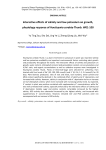
Статья научная
Houttuynia cordata Thunb. is a plant enrichment in potassium in plant was reported. Salinity and low potassium availability are important environmental factors restricting plant growth and productivity throughout the world. The interactive effects of salinity and potassium on growth, water content, chlorophyll content, lipid peroxidation content, ion accumulations and K+/Na+ ratio, and organic accumulations as well as oxidative enzymes were investigated in Houttuynia cordata Thunb.. Plants of three-leaf-stage were selected for uniformity, then treated with four levels of Na+ (50, 100, 200 mmol/L) and K+ (0, 0.6, 1.2, 2.4 mmol/L) for 20 days. Plant biomass production, ratio of root and shoot, root numbers, water content and MDA content significantly declined in the combined effect of salinity and K+ deprivation, and increased with salinity. However, salinity in conjunction with K+ deprivation led to an increase on leaf chlorophyll content, which even increased with increasing salinity levels. As expected, K+ content in plant was positive correlated with supplementary K+ concentrations, while Na+ was well correlated with salinity, especially enhanced by the interactive effects of salinity and K+ deprivation. Soluble sugar and proline contents remarkable increased by the highest salinity. SOD activity also substantial increased by the highest salinity, and increased with supplementary K+ concentrations. However, elevated CAT and POD activities were not accompanied with an increase in SOD activity.
Бесплатно

Статья научная
Hydrolytic enzymes of Bacillus attracting a great attention due to their various applications in industrial bioprocesses. In this work, out of 525 Bacillus isolates, 40 were screened for their potential capacity to produce hydrolytic enzymes including xylanase, lipase, amylase, pectinase, protease and carboxymethyl cellulose (CMC) using agar plate assay. A pure culture of each isolate was streaked on the surface of agar media containing suitable substrate specific for every enzyme activity, and the diameter of hydrolytic zones were measured. Data showed clear zones around the colonies which were interpreted as evidence of the enzymes activities. The isolates were able to generate at least one of these enzymes among which CMC and protease were the most common enzymes detected in 40 isolates; amylase in 39, xylanase in 36, lipase in 32 and pectinase in 26. Based on 16S rRNA gene sequencing the isolates were classified as B. atrophaeus , B. amyloliquefaciens , B. subtilis , Paenibacillus polymyxa , B. simplex and B. tequilensis . The native B. tequilensis isolates formed the largest zone clearance and had high abilities to produce five hydrolases. The isolates which had the largest enzymatic activity zones and the largest diameter of the clear hydrolysis zones on agar plates were submitted for further research work and enzyme-based industrials.
Бесплатно
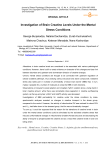
Investigation of brain creatine levels under the mental stress conditions
Статья научная
Alterations in brain creatine levels are considered to be associated with various pathological conditions. However, there is still no exact evidence on character of this changes and clear link between disorders and upstream and downstream direction of creatine changes. Chronic mental stress conditions are thought to be connected with upstream regulation of cellular oxidative pathways, thus oxidizing various structural and active compounds. Oxidative stress also takes part in increase of permeability of blood brain barrier (BBB) that, in turn, makes it possible for a number of molecules to cross the BBB in both directions. Observations on long-term social isolation and circadian rhythm violation show a rising trend in brain creatine amount, while there was remarkable down-regulation in creatine synthesizing system, as the key-enzymes’ (AGAT and GAMT) activity was decreased. Investigations of BBB permeability for creatine under the stress conditions by mass-spectrometric analyses revealed no changes in creatine transport in the stress group, compared to the control. However, the activity of mitochondrial CK was reduced for about 25% and Vmax had fallen down in the stressed group, the Km was not drastically changed. To sum up, it could be supposed that the reason for the elevations of creatine levels in brain under the mental stress conditions could be stimulated by the activated oxidative stress that induces conformational changes in mitochondrial Creatine Kinase structure and decreasing the ability of enzyme to phosphorylate the creatine and as a result free creatine levels in brain are being arisen.
Бесплатно
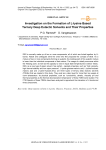
Investigation on the formation of L-lysine based ternary deep eutectic solvents and their properties
Статья научная
DES is normally made up of two or more components, all of which are linked together by H-bonds. Abbott and colleagues were the ones who first proposed the concept of DES. As a mixture of two or more components forming an eutectic, the melting point of this eutectic mixture is lower than the individual components of that mixture. The usage of a totally enormous within the freezing point, as well as the capacity to exist in liquid state temperatures is below 150oC. DES, as a new type of green solvent, has certain - reputed properties, such as “high viscosity, high thermal stability and low vapor pressure”. L-lysine-glucose-malonic acid, L-lysine-fructose-malonic acid and L-lysine-fructose-ZnCl2 are three types of ternary deep eutectic solvents (TDESs) that we created in this study. They exist as a clear liquid for more than two weeks at room temperature. Its physical properties, such as “conductivity, density, viscosity pH and thermal properties as the thermal decomposition temperature” of these TDES were studied. The FTIR Spectra of those TDESs have been analyzed to apprehend the interaction of H bonds and three components.
Бесплатно
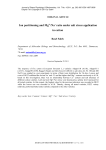
Ion partitioning and Mg2+/Na+ ratio under salt stress application in cotton
Статья научная
The response of five cotton (Gossypium hirsutum L.) varieties (A118), Aleppo33/1 (A33/1), Aleppo90 (A90), Raqqa5 (Raq5) and Deir-Ezzor22 (DE22) to salt stress (, 50, 100 and 200 NaCl) was studied in a pot experiment, in terms of their ionic distribution 56 days.and roots of DE22 exhibited the lowest Na+and Cl-and the highest leaf Mg2+contents conversely to A118. on this investigation, was no relationship between 2+content and salt tolerance of different cotton varieties. and root Mg2+/Na+ratios were decreased as salinity level increased for all tested varieties. In this respect, the value for the previous indicators was recorded in DE22 while the lowest one was recorded in A118. Thereby, among all tested varieties, DE22 variety relatively performed better under salinity compared to the other varieties.
Бесплатно
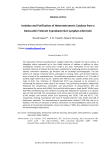
Статья научная
The desiccation tolerant cyanobacterium Lyngbya arboricola, isolated from bark surfaces of Mangifera indica, possessed up to four stable isoforms of catalase in addition to other antioxidative enzymes, for several years under a dry state. Purification of the two most persistent isoforms of catalase (Cat) has been undertaken by employing acetone precipitation, ethanol: chloroform treatment, gel filtration and ion exchange chromatography. The two isoforms of catalase remained almost unchanged on varying matric and osmotic hydration levels of mats of the cyanobacterium. The purification procedures resulted in a 1.3 % yield of purified single isoform (0.22 mg mL -1 protein) with 709 Units mg -1 specific activity and a purity index of 0.83. Five millimolar of dithiothreitol (DTT) was observed to be pertinent in maintaining the optimum redox state of the enzyme. The purification procedures additionally facilitated the simultaneous elimination and procurement of phycoerythrins (PE) and mycosporine-like amino acids (MAA). Each purified isoform gave a single band (~45kDa) upon SDS-PAGE and denaturing urea isoelectric focusing (IEF) depicted the presence of 2 subunits each of CatA and CatB. The monoisotopic mass and pI value of CatA and CatB as revealed by LC-MS analysis and internal amino acid sequencing was 78.96, 5.89 and 80.77, 5.92, respectively, showing resemblance with CatA of Erysiphe graminis subs. hordei and CatB of Ajellomyces capsulata. The heterotetrameric monofunctional catalase (~320 kDa), due to its stability in the form of resistance to ethanol: chloroform, its thermoalkaliphilic nature and the presence of innumerable hydrophobic amino acid residues (~40%), thus exhibited its potential for biotechnological applications.
Бесплатно

Isozyme analysis on different varieties of sugarcane
Статья научная
Isozymic and protein diversity among five sugarcane varieties viz., Co 6304, Co 85019, Co 8371, Co 89003 and Co 91010 were studied to understand the varietal interrelationship and to identify the biochemical marker for the disease resistance and stress tolerance. The standard technique of vertical gel electrophoresis PAGE was employed for size separation of isozymes. The gel was stained with different staining solutions for different isozyme systems viz. peroxidase, esterase, acid phosphatase, alkaline phosphatase and proteins. Rfvalues of the banding profiles, similarity index and variation between the varieties were analysed. Among the four enzyme systems, peroxidase profile reveals the difference between the disease resistant / susceptible and abiotic stress tolerant / non tolerant varieties. The two isoperoxidase bands with Rf values 0.62 and 0.66 showed their presence in disease resistant and abiotic tolerant varieties. The presence of two marker bands (0.62, 0.66) of resistant and stress tolerant varieties suggest that the variety Co 6304 may also be resistant to smut, wilt and moderately resistant to red rot and tolerant to drought.
Бесплатно
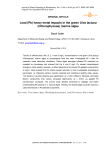
Lead (PB) heavy metal impacts in the green Ulva lactuca (Chlorophyceae) marine algae
Статья научная
Toxicity of different lead (Pb) (0, 2, 4 and 8 mg/L) concentrations in the green Ulva lactuca (Chlorophyta) marine algae at physiological level has been investigated 48 h after Pb treatment under laboratory conditions. Thalus algae damages followed Pb treatment as revealed by microscopy test showed that the 4 and 8 mg/L Pb caused morphological changes in cells viability; whereas, no effect observed at the lowest Pb applied concentration (2 mg/L). Data revealed that Pb stress caused reduction in most investigated physiological parameters i.e. Pigments content, osmotic potential and membrane stability index values. This decline in osmotic potential was significantly ( p ≤ 0.001) different. Whereas, estimated electric conductivity (EC) values increased significantly ( p ≤ 0.001) as applied Pb concentration increased. The current study allowed somewhat to highlight and better understanding Pb impacts in U. lactuca algae. Thereby, the studied algae could be used as a useful bioindicator in Pb polluted ecosystems.
Бесплатно
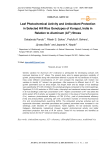
Статья научная
Genetic variation for Aluminum (Al3+) tolerance is prerequisite for developing cultivars with improved tolerance to Al3+ stress. The present study aims to assess genotypic variability of growth, photosynthesis along with antioxidant defense in popular hill rice landraces of Koraput, India under different concentrations of Al3+ and compare the responses with modern rice varieties to identify Al3+ tolerant rice genotypes. After exposure to different level of Al3+, the growth parameters such as shoot length, root length, fresh and dry weight of rice seedlings were significantly (P3+. Higher concentration of Al3+ also alters the photo system (PS) II activity, as revealed in the reduction in the values of maximal fluorescence (Fm), maximum photochemical efficiency of PSII (Fv/Fm), yield of photochemical efficiency [Y(II)] and photosynthetic quenching (qP) with concomitant increase of minimal fluorescence (Fo) and non-photosynthetic quenching (NPQ)...
Бесплатно
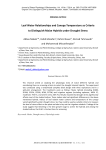
Статья научная
This research aimed at studying the physiologic traits of maize different hybrids and considering them as screening criteria to select the drought tolerant hybrids. The experiment was conducted using a randomized complete block design with three replications and in a split-plot arrangement. The treatments were as follows: Maize Hybrids (including SC400, ZP434, SC524, ZP599, BC66, SC704) and irrigation regimes (including optimum; 100% FC, moderate; 75% FC, and severe stress; 50% FC). Results showed that drought stress significantly affects most of the studied indices. These indices also had significant differences in the above mentioned hybrids. Indices of leaf relative water content and temperature of the canopy varied significantly under drought stress. So, they could be used as suitable criteria to measure the level of stress effect on the plant and also to lay out the irrigation schedule. Findings of the study suggest that blistering is the best growth stage to screen the hybrids and among the studied indices, the ELWL is the best item for screening.
Бесплатно
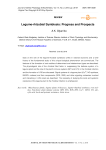
Legume-rhizobial symbiosis: progress and prospects
Статья обзорная
Data on the role of the legume-rhizobial symbiosis (LRS) in national economic and a brief history of the fundamental study of this unique biological phenomenon are summarized. The features of the formation of root nodules of determinant and indeterminant types are described. The physiological role of the rhizobial Nod factor in suppressing the defense system of a legume plant and the role of the plant's immune systems (MTI and ETI) in the rhizobial infection and the formation of LRS are discussed. Signal systems of a legume plant (Ca2+, NO-synthase, NADPH oxidase) and their components (ROS, RNS) and other signaling molecules involved and interacting in LRS onset are described. The necessity of studying the local and systemic resistsnce of the legume plant to the rhizobial infection is emphasized.
Бесплатно
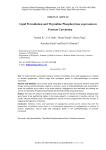
Lipid peroxidation and thymidine phosphorylase expression in prostate carcinoma
Статья научная
Aim: To understand the association between markers of oxidative stress and angiogenesis in relation to disease progression, clinical stage and cytological grade in patho-physiology of prostate carcinoma. Patients and Methods: Case control study comprised of 50 prostate carcinoma patients along with 20 age and sex-matched healthy subjects as controls. Levels of malondialdehyde were measured to study the oxidative stress status in the study subjects. Angiogenesis was evaluated by studying the activity of Thymidine Phosphorylase/Platelet derived endothelial cell growth factor. Results: The levels of markers of oxidative stress along with the activity of thymidine phosphorylase were found to be significantly higher in the study subjects in comparison to healthy controls. The results indicate oxidative stress and angiogenesis activity increase progressively with the increase in staging and progression of disease. Conclusion: Oxidative stress and expression of angiogenesis activity points clearly that with the progression of oxidative stress there is a simultaneous progression of angiogenesis in relation to disease progression, clinical stage and cytological grade in the pathophysiology of prostate carcinoma.
Бесплатно
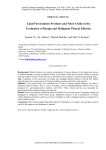
Статья научная
Background: Pleural effusion is a common complication of various diseases. Free radicals are known to produce damage in many biological tissues. Free radicals exert their cytotoxic effect by causing lipid peroxidation which is believed to be responsible for the exudation of fluid into the pleural space. Aim: Evaluation of the association of benign and malignant pleural effusion with the free radical induced pleurisy by measurement of lipid peroxidation products and nitric oxide activity. Methods: Case control study was conducted on 50 cases of benign pleural effusion, 50 cases of malignant pleural effusion and 15 cases of healthy controls. Malondialdehyde (MDA) levels were measured by spectrophotometric method with TBA. Nitric Oxide activity was measured by spectrophotometric method using Griess reaction. Results: Our results showed significant increase of MDAs level in both groups of patients: benign and malignant in comparison with control group. Significant increase in the concentrations of nitrate /nitrite depicting total nitric oxide was observed in benign as well as malignant group in comparison to control healthy group. Conclusion: These results suggest that determination of biomarkers of oxidative stress products may be useful in the diagnosis and treatment of patients.
Бесплатно
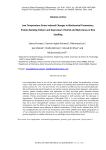
Статья научная
Low temperature stress is one of the main abiotic factors that reduce the productivity of many crops in hilly areas around the world. In this study, rice seedling were exposed to low temperature stress (control, 0°C, -2°C, -4°C and -6°C) for 2 hr to observe its effect on two rice varieties (Basmati- 385 and Shaheen Basmati) through ion and proline contents, photosynthetic pigments, total protein content, protein banding pattern and expression of Zat12 and Myb genes. Resulted showed different patterns of accumulation of Na + K + and Ca +2 ions with the decrease in temperature in both varieties. Proline accumulation was gradually increased in both varieties with the decrease in temperature. Photosynthetic pigments (Chlorophyll (Chl) a, b and carotene) were negatively affected by low temperature stress in both varieties, however, carotene content was much affected than Chl a and b. Nonsignificant variation in protein contents was observed at all levels of low temperature, but the effects of low temperature stress on protein banding pattern of Basmti-385 and Shaheen Basmati were different at different treatments. RT-PCR results indicated that ZAT12 was upregulated by short term low temperature stress while OsMYB show slight upregulation at -2 oC as compared to the other treatments. This study identified that ZAT12 and OsMYB function as a positive regulator to mediate tolerance of rice seedlings at low temperature stress.
Бесплатно
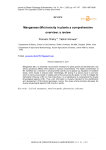
Manganese (Mn) toxicity in plants a comprehensive overview: a review
Статья обзорная
Manganese (Mn), an essential micronutrient necessary for plant growth and development, has serious phytotoxic effects when present in surplus concentrations. The higher concentration of Mn manifests as a reduction in photosynthetic activity and a gradual up regulation of oxidative stress, which results in reduced yield. Interestingly, Mn toxicity is a serious issue in acid soil, which is mainly encountered in sizable parts of the soil across the globe. In order to mitigate the detrimental influence of Mn on crop productivity, it is of significance to comprehend the diverse physiological aspects of Mn. Thus, such information is crucially important for the identification and development of Mn-tolerant genotypes. Hence, this review article precisely discusses the diverse physiological aspects of Mn toxicity in plants.
Бесплатно
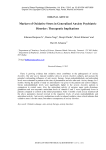
Markers of oxidative stress in generalized anxiety psychiatric disorder: therapeutic implications
Статья научная
There is growing evidence that oxidative stress contributes to the pathogenesis of anxiety disorders. Our aim was to measure oxidative stress in anxiety disorders subjects, and assesses the potential confounding influences of anti anxiety therapy. Serum malondialdehyde and antioxidant levels were estimated in patients at the time of presentation and also after anti- anxiety therapy for 3 months. During the period of study no antioxidant/s was given to the patients and control subjects. Serum malondialdehyde levels were significantly higher in the anxiety disorders patients in comparison to control cases. Also, the antioxidant activity of enzymes super oxide dismutase, glutathione and non enzymatic antioxidant levels of vitamins E and C were significantly lower in patients compared to controls at the initial presentation. After 3 months of anti anxiety treatment all the above parameters showed reversal in the respective levels of serum malondialdehyde and antioxidant activity. Anti anxiety medications results in reduced oxidative stress which indicates that oxidative stress is not the cause, but rather a consequence,of anxiety disorders.
Бесплатно
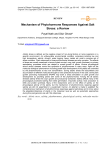
Mechanism of Phytohormone Responses Against Salt Stress: a Review
Статья научная
Abiotic stress is defined as the negative impact of non-living factors on living organisms in a specific environment. An unfavourable environmental condition comprising extreme low and high temperature, salinity, drought, water logging, heavy metals etc. pose a complex set of stress condition. Plant responses to those environmental stresses are also complex. The effects of stress are usually measured in terms of plant survival, crop yield, growth (biomass) or primary assimilatory processes which are related to overall growth of plants. Various physiological stimuli and/or stresses control the synthesis of phytohormones in many ways. Again all the molecular biological phenomenon including growth and development of the plants are controlled by the phytohormones at very low concentration. During abiotic stress the biosynthesis and accumulation of different molecules thought to have protective functions in the cells. Some plant growth promoting rhizobacteria (PGPR) may exert a direct stimulation on plant growth and development by providing plants with some of the phytohormones. Among the all abiotic stresses salinity limits the crop’s growth and productivity worldwide. Salinity affects many of the physiological processes starting from seed germination, enzymatic activity, food production to DNA and protein synthesis. Many of the researchers work on the effect of salinity on the physiological activity of the plants, but the mechanism of phytohormones response against salinity are still not assembled in a systematic manner. An attempt is made to establish the comprehensive mechanism of phytohormones responses against salt stress and to know about the adaptation/tolerance of plants in the molecular level as well as systematic approaches during this post genomic era with 164 references.
Бесплатно
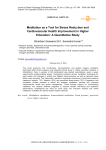
Статья научная
This study examines how mindfulness, transcendental, and guided imagery meditation techniques affect blood pressure and subjective stress levels in higher education students in Uttarakhand, India. A sample of 400 participants was studied quantitatively using a quasi-experimental pretest-posttest design. Participants practiced various meditation techniques for eight weeks, and changes in systolic and diastolic blood pressure, as well as reported stress levels, were recorded. The intervention resulted in significant reductions in both blood pressure measures (systolic: 70%, diastolic: 65%) and perceived stress levels (75%). Regression and correlation studies revealed a robust link between meditation practice and improved cardiovascular health and stress management. These findings support for incorporating meditation into campus wellness programs to improve student well-being and academic performance, emphasizing the need for more study into long-term impacts and varied meditation modalities for optimal student health initiatives.
Бесплатно
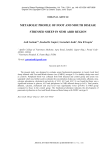
Metabolic profile of foot and mouth disease stressed sheep in semi arid region
Статья научная
The present study was designed to evaluate serum biochemical parameters in twenty local bred sheep infected with Foot-and-Mouth disease virus (FMDV) serotype O. Ten healthy sheep were used as controls. Peripheral blood was collected from both diseased and control group and serum was separated which was further used to estimate the concentration of glucose, total protein, albumin, urea, calcium, phosphorus, cholesterol and activity of AST, ALT and ALP. It was found that there was a significant increase in glucose, AST and phosphorus in FMD affected sheep (p
Бесплатно

Статья научная
Background: Lantana camara, Parthenium hysterophorus, Ageratum conyzoidus and Ricinus communis are underutilized plants. These plants are traditionally used in many health related areas. The context and purpose of the study: To investigate the photochemicals present in underutilized plants Lantana camara, Parthenium hysterophorus, Ageratum conyzoidus and Ricinus communis : Methods: Qualitative, quantitative screening, compound identification by UV-VIS method and Fluorescent spectroscopy and FT-IR based identification of functional groups of active chemical components were studied. Organic solvents leave extracts (ethanol, methanol, acetone) were tested for availability of secondary metabolites. Results, the main findings: UV-VIS spectrum showed different peaks with different absorption in all plants. The method of quantitative analysis in UV-VIS spectrum was proved in terms of linearity, LOD and LOQ AND various secondary metabolites were detected in the plant extracts. Florescent analysis confirmed the presence of secondary metabolites like alkaloids and phenolics. The FT-IR spectrum values indicated the presence of C-H stretching, O-H bending, C-C stretching and confirmed the presence of alcohols, phenols, alkanes and amines in acetone extracts. Conclusion: The results confirmed the fact that these plants poses important bioactive components useful for human mankind, so further investigation may needed.
Бесплатно

